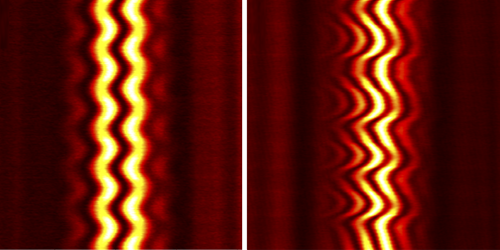June 20, 2017 report
Soliton molecules caused to vibrate like real molecules

(Phys.org)—A team of researchers with the University of Burgundy in France has shown that solitons can vibrate like real molecules when paired. They have published a paper describing their technique and findings in the Physical Review Letters journal.
Solitons are quasiparticles that propagate along a non-dissipative wave. Put another way, they are waveforms that hold their shape as they move—like a single wave moving across the surface of a pond. Many examples of solitons have been created and studied, including what happens when two or more of them travel in the same medium and react due to their attraction to one another. Prior studies have suggested that in some cases, the bonds that form between two solitons can cause them to vibrate like a molecule, but until now, no one had been able to actually observe such vibrations occurring.
Notably, solitons created and sent through optical fiber cables are made from very bright pulses of light—bright enough to cause a change to the fiber cable to disallow the light from the pulse from spreading out and weakening. In this new effort, the researchers conducted their research on solitons using such an arrangement.
To capture the vibrations, or oscillations, the team developed a new way to use a dispersive Fourier transform. They sent solitons into an optical fiber with an added frequency-dependent delay and monitored the action with a fast detector. Doing so allowed the researchers to convert the pulse of light into a waveform that was extended in time. When pairs were sent through the fiber cable, the researchers found they were able to observe them bond and to oscillate with an amplitude of approximately 1ps. They also found something else—the relative phase of the solitons also oscillated. The team notes also that they were able to change how the "molecules" of light behaved by fine tuning their apparatus.
The results suggest that it may be possible to cause fiber optic cables to carry more information—instead of a pulse carrying just one bit, it might be possible for it to carry two, simply by creating paired solitons and sending them through.
More information: Katarzyna Krupa et al. Real-Time Observation of Internal Motion within Ultrafast Dissipative Optical Soliton Molecules, Physical Review Letters (2017). DOI: 10.1103/PhysRevLett.118.243901
ABSTRACT
Real-time access to the internal ultrafast dynamics of complex dissipative optical systems opens new explorations of pulse-pulse interactions and dynamic patterns. We present the first direct experimental evidence of the internal motion of a dissipative optical soliton molecule generated in a passively mode-locked erbium-doped fiber laser. We map the internal motion of a soliton pair molecule by using a dispersive Fourier-transform imaging technique, revealing different categories of internal pulsations, including vibrationlike and phase drifting dynamics. Our experiments agree well with numerical predictions and bring insights to the analogy between self-organized states of lights and states of the matter.
Journal information: Physical Review Letters
© 2017 Phys.org















